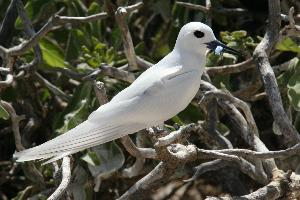
Animal description
The Little White Tern, scientifically known as Gygis microrhyncha, is a captivating bird species that belongs to the family Laridae, which encompasses gulls, terns, and skimmers. This bird is often admired for its ethereal appearance and delicate features. Primarily found in the tropical and subtropical regions of the Pacific and Indian Oceans, the Little White Tern is a marvel of avian adaptation and beauty.Physical Description:
The Little White Tern is characterized by its predominantly white plumage, which serves as an excellent camouflage against predators when flying above the sparkling ocean waters. It has a slender body that measures approximately 25-30 cm in length, making it one of the smaller tern species. Its wings are long and narrow, designed for swift and agile flight. The bird's beak is sharp and pointed, colored in a striking black, contrasting beautifully with its white feathers. Its legs and feet are also black, adding to its elegant appearance. One of the most distinctive features of the Little White Tern is its small, black eye, which seems to sparkle against its snowy plumage.
Habitat and Distribution:
The Little White Tern favors tropical and subtropical climates and is primarily found nesting on coral islands, atolls, and sometimes on rocky islets. Its range spans across a vast area of the Pacific and Indian Oceans, with populations found from the central Pacific islands to parts of Southeast Asia and the eastern coast of Africa. These birds are highly adapted to life at sea and are seldom seen inland, except during breeding seasons when they venture to coastal areas to nest.
Behavior and Diet:
The Little White Tern is a remarkable forager, often seen skimming the ocean's surface for small fish and invertebrates. It employs a variety of hunting techniques, including hovering over the water to spot prey before diving in to catch it with precision. This bird is also known for its graceful flight, capable of swift turns and dives, which is not only a hunting adaptation but also a display during mating rituals.
Reproduction and Lifecycle:
The breeding season of the Little White Tern varies depending on its location but generally occurs during the warmer months. Unlike many other bird species, the Little White Tern has a unique nesting habit. It does not construct a traditional nest; instead, it lays its single egg on bare branches or in a shallow depression on a cliff edge, relying on its camouflage and the inaccessibility of the site for protection. Both parents share incubation duties and later, the responsibility of feeding the chick until it is ready to fledge. The chick's plumage develops quickly, a necessary adaptation to its exposed nesting sites.
Conservation Status:
Currently, the Little White Tern is not considered to be at immediate risk, with stable population numbers in most of its range. However, like many seabirds, it faces threats from habitat destruction, pollution, and the impacts of climate change, which could affect its breeding sites and food availability. Conservation efforts are crucial to ensure that this species continues to thrive in its natural habitat.
In summary, the Little White Tern is a small, graceful bird whose life is intricately connected to the marine environment. Its elegant appearance, remarkable foraging skills, and unique breeding habits make it a fascinating subject of study and a beloved sight among birdwatchers and nature enthusiasts.
Similar Animals
New photos of animals
Top 10 animals
- Dolphin gull (Leucophaeus scoresbii)
- Diana monkey (Cercopithecus diana)
- Moustached guenon (Cercopithecus cephus)
- Galápagos tortoise (Geochelone nigra complex)
- Japanese macaque (Macaca fuscata)
- Stone loach (Barbatula barbatula)
- Greek tortoise (Testudo graeca)
- Russian tortoise (Testudo horsfieldii)
- Common flying dragon (Draco volans)
- Galápagos penguin (Spheniscus mendiculus)


